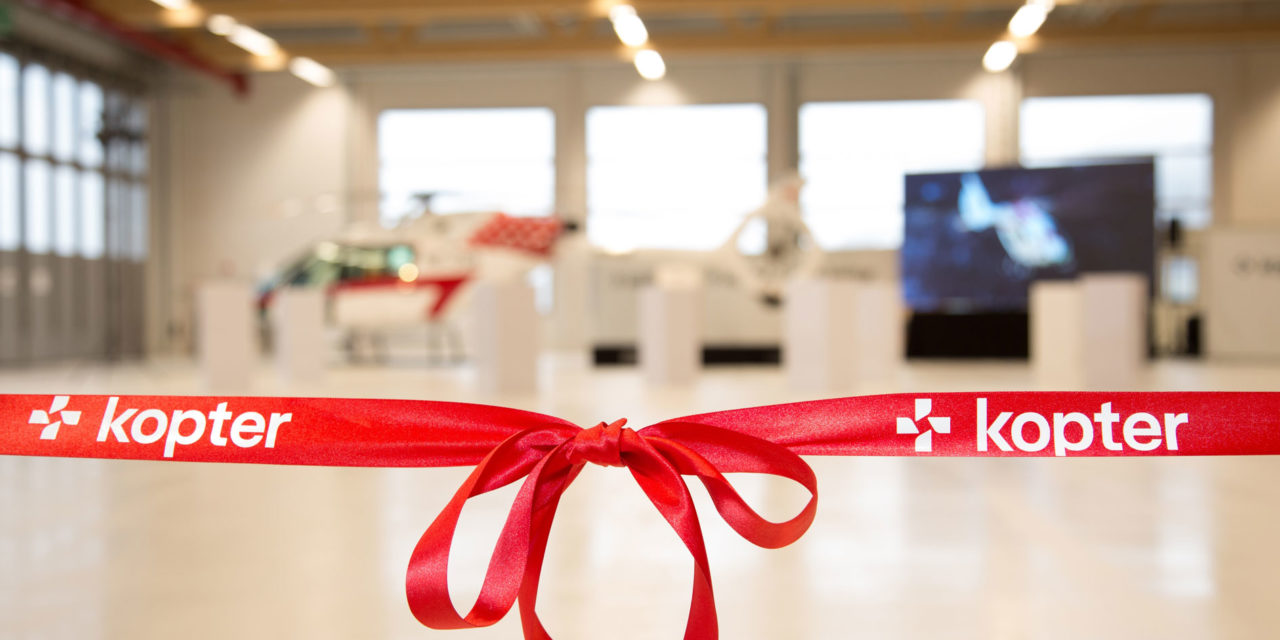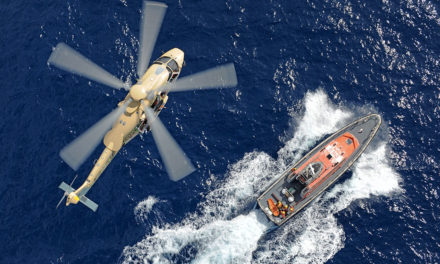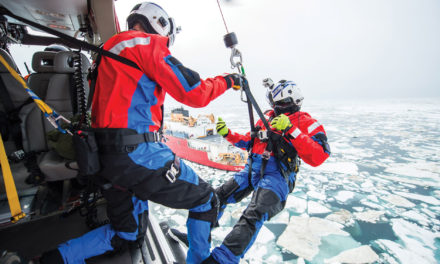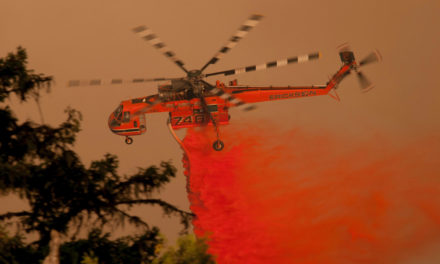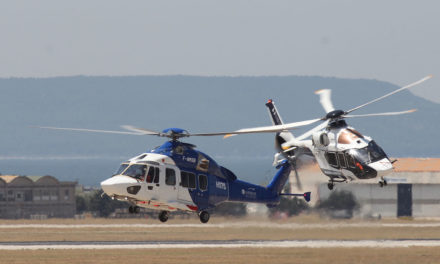Helicopter Industry met with Andreas Löwenstein, CEO of Kopter, during Heli Expo 2018 in Las Vegas. A successful exhibition for the Swiss helicopter manufacturer, with the signing of 23 firm orders and 11 options, and which resulted in a hectic schedule of its leader. He did however find the time to speak to us to sum up the current situation for his company. After several years of training and warming up, the monoturbine SH09, weighing 1.4 tons empty, has finally stepped into the ring. The fight between the sector’s heavyweights has only just begun…
You announced 23 firm orders and 11 options during the Expo. What are the numbers looking like now?
At the end of Heli Expo we have more than 160 firm sales and letters of intent. This total includes more than 30 firm sales with down payment and 29 Memorandum of Agreement. It was also important to me that these different sales are made to launch customers who are well established companies, flying a lot and with a good maintenance infrastructure. This has been done with operators like Helitrans in Norway, Alpin Lift or Air Zermatt in Switzerland. These first customers will use our aircraft intensively, in a JAR45 environment, with mechanics and professional pilots of very high level. And then, we also targeted operators with very large fleets, like Papillon or Paradise Helicopters. Our sales were all made to leading companies and major operators.
What about distributors? Do you have ambitions to create a global network?
We already have six authorized distributors and we are going to go up to fifteen-or-so in the first instance. We will be present almost everywhere in the world – Asia, Europe, North America, South Africa – except, for the moment, in Russia. We want to be on par with the global single-engine market leaders: we will not be a niche player. Our order book reflects this market very well, with approximately 50% of demand from North America.
Among the various markets open to single-engine aircraft, which is your priority?
As soon as it is put into service, our aircraft will have the various tools enabling it to fulfill the most important missions: winch, medical equipment, lifting hook … And this versatility is already reflected in our sales: we have tour operators, specialists in aerial work or EMS [their names are for the moment kept confidential, ed.]. We still lack police forces that use single engines in the United States. These seek above all excellent visibility to the ground, large cabins and power. So many of the things we achieve at the highest level with the SH09. The police have not had the opportunity to try our aircraft yet, but I am very optimistic because we are quite credible in the missions we are aiming for.
The medical transport market (EMS) is estimated to have 2,400 aircraft in the United States alone, but it is also highly competitive. How do you plan to approach it?
EMS contracts are very competitive in the United States, since they are challenged every three or four years. If we can prove that the SH09 is THE EMS machine par excellence, which I believe, and a massive upward turn in our favor is possible. Today, the most purchased aircraft in this segment are the H135 and H145. Why? Not because they are twin-engine, which is a handicap in this case, but because operators are looking for a large cabin. But with the SH09, we offer practically an H145 sized-cabin for the cost of operating a single engine. SH09 will also be IFR as soon as it is placed on the market.
Did you suffer or even lose sales due to the weak Dollar?
Customers see the difference that comes with our single-engine aircraft, with a bigger cabin and better range than the competition. The advantages that we put forward can justify looking at the price last. And anyway, our price is still very competitive, because we are not affected by the flux in exchange rates: we have set up a system where we buy components in the three currencies – the Euro, the Dollar and Swiss francs. The engine and avionics are, for example, paid for in Dollars, which is already a major part of the purchase price of the aircraft.
Where are you up to in developing the machine?
We have completed more than 70 hours of flight since the beginning of the program with the first two prototypes, while accumulating several hundred hours of bench tests: the anti-torque transmission / rotor assembly has run for more than 2,000 hours, the transmission / main rotor assembly over 500 hours … The PS4, which will be the pre-production unit, will be delivered at the end of the summer and will participate with the PT3 in the certification flights that will take place in Sicily. We plan to stay on the Italian island for about a year, with a maintenance infrastructure that can accumulate nearly 1000 flying hours on site.
When do you envisage getting the certificate?
The certification consists of three parts: the documentary part, the materials and components tests and the flight tests, the aim being that these three parts converge in advance of the EASA work. AESA certification, along with FAA certification, are both envisaged during the first months of 2019.
Where are you up to in manufacturing terms?
Our manufacturing plan is similar to that of a two-stage rocket: the first stage, installed in a first plant, consists of the manufacture of pre-assembled subassemblies: blades, hydraulic and dynamic components. The tools are in place or will soon be – we are calibrating the operations. A stone’s throw from this first building, the second area consists of a hall of 4,200m2, with an assembly capacity of a hundred aircraft a year, which we have just inaugurated on February 1st. This building, located in Mollis [about fifty kilometers east of Zurich, ed.], will also host training and flight test activities. The first series helicopters will come out of Mollis next year.
Would you like to set up assembly lines elsewhere in the world?
Yes, absolutely. We want to do it like a famous Swedish furniture manufacturer: we will manufacture kits, this is the first floor of the rocket, which can be sent to assembly lines (FAL) anywhere in the world. Some will cross the street and go to the Mollis FAL. But others will be able to go to the United States as early as 2021, and to Asia two years later. We are having ongoing discussions, and all that will depend on the market. It is obvious that if anyone wants to invest in Kopter, we will favor them when installing a final assembly line.
Where are you thinking of setting up in the United States?
In one of the country’s two major aeronautical centers, where there is qualified labor and you are in close proximity to major customers…
Where and how are you going to recruit the manpower necessary for your rise to power?
We recruited a lot in 2017 (112 people to be precise). And we expect to add about a hundred people to our workforce in 2018. We will continue to grow in the coming years, but the numbers will not be as dramatic. From the point of view of recruitment, it is true that the Swiss aeronautical industrial fabric is very narrow, being limited to a few thousand people. But we know how to adapt: we will train many employees ourselves. We will set up a “Kopter learning system”, recruiting a mix of Swiss nationals and foreigners. We have the means of attracting talent and the Swiss system is attractive too: both financially and fiscally, and the administration runs like clockwork. It does not take more than ten minutes in a town hall to settle all immigration administrative issues. Our central geographical position in Europe, between France, Germany, Italy – and even beyond – is also an asset: our 263 employees are of 19 different nationalities. And then, it is necessary to defeat a conventional wisdom: the idea of a high production cost for advanced technological goods in Switzerland is a myth. Income tax is limited to 20%, compared to much more in France: so we can pay higher wages, it’s that simple. Corporate tax levels are also very low.
By Frédéric Lert
@photos by Kopter

